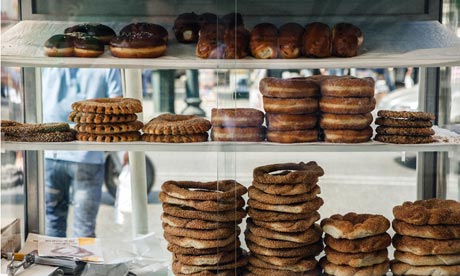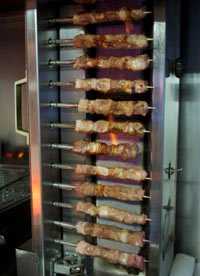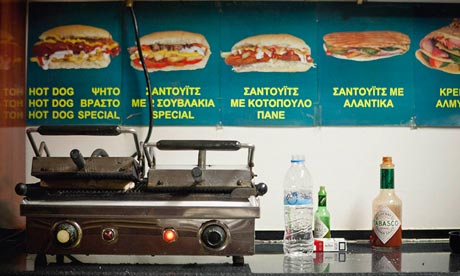Source: theguardian.com
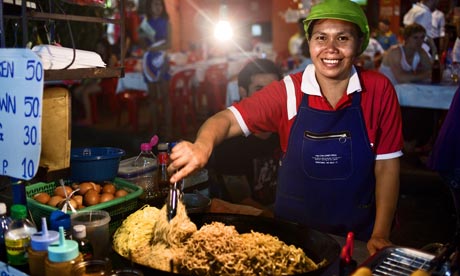
Street food stall in Bangkok, Thailand. Photograph: Luigi Vaccarella/SIME/SIME/4Corners Images
Mohinga, Burma
What is it? This
comforting noodle soup exemplifies the earthy flavours of the country's
cuisine. It is fish broth thickened with rice or bean powder, and
typically containing a combination of shallots, the crunchy edible core
of the banana tree, thin round rice noodles and chopped coriander.
Origin Mohinga
is made from almost exclusively indigenous ingredients, suggesting that
the dish has native origins; most south-east Asian noodle dishes can be
traced back to China.
Tasting Mohinga is sold in
just about every town in Burma, typically from mobile carts and
baskets, or basic open-fronted restaurants. Mohinga vendors are most
prevalent in the morning. Ordering is simple, as the only optional
ingredient is
akyaw (crispy fritters of lentils or vegetables).
The thick broth has flakes of freshwater fish (typically snakehead
fish), a yellow/orange hue due to the addition of turmeric, and a light
herbal flavour, thanks to the use of lemongrass.
Finding it in Burma … If
you're in Rangoon, head to Myaung Mya Daw Cho (118A, New Yae Tar She
Lane, Bahan Township) where a bowl will set you back K5 (50p).
And in the UK … There is no Burmese
street food in the UK. The Mandalay (
mandalayway.com/restaurant/index.html) is a Burmese restaurant on London's Edgware Road. Its fritters and
ohn no khao swe (coconut chicken noodles) are pretty authentic. Mohinga is on the menu, spelt
mokhingar.
Banh mi, Vietnam
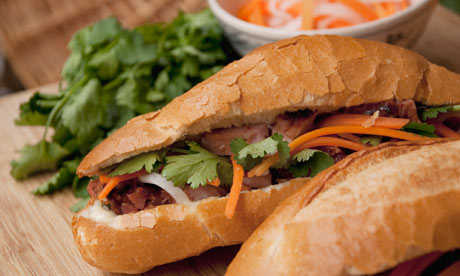 Photograph: Rebecca Skinner/Lonely Planet
What is it?
Photograph: Rebecca Skinner/Lonely Planet
What is it? A little-known secret is that the
world's best sandwich isn't found in Rome, Copenhagen or even New York
City, but on the streets of Vietnam. It begins with a light baguette
grilled over coals. After a smear of mayonnaise and a dollop of pâté,
the crispy shell is filled with meat, crunchy pickled vegetables and
fresh herbs. It is then typically seasoned with a few drops of soy sauce
and a spicy chilli condiment.
Origin An early example of fusion food,
banh mi shows an obvious link with the French, rulers of Vietnam in the early 20th century. Other ingredients, including
xa xiu, the barbecued pork better known as
char siu, have Chinese origins, while the herbs and seasonings are distinctively south-east Asian.
Tasting Banh
mi is the epitome of street food: the sandwiches are sold almost
exclusively from stalls and vendors. Seating usually takes the form of
tiny plastic stools, and the sandwiches are generally served to go,
wrapped in recycled paper. Pâté? Meatballs or grilled pork? Chilli?
Mayonnaise? Diners choose their meats, toppings and condiments. A
collection of the best of south-east Asian cuisine in a western package.
Finding it in Vietnam … If
you're in the coastal city of Hoi An, head to Phuong on Hoang Dieu, a
legendary banh mi stall where a sandwich costs 15,000 dong (about 45p)
And in the UK …
Anh and Van, two schoolfriends from Hanoi, came up with the name
Banhmi11 because, in their mind, the perfect banh mi is 11 bites big.
They make everything from scratch, even pickling their own daikon. They
now trade in London's Broadway market .
Daulat ki chaat, Delhi, India
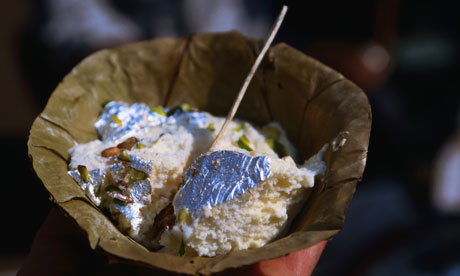 Photograph: Greg Elms/Lonely Planet
What is it?
Photograph: Greg Elms/Lonely Planet
What is it? This sweet, delightful treat is as light
as air and as heavenly as moonlight. Sweetened, whisked milk is
decorated with saffron, giving it an appealing orange-and-white tint. On
to this is sometimes added a layer of edible silver leaf called
varq. Although it's little more than insubstantial froth, it has a unique taste. It's a popular Old Delhi street snack in winter.
Origin It's possible that Mughal emperors were among the first to savour this treat.
Tasting The
first taste imparts a hint of butter, then the tongue detects the
subtle flavour of saffron, followed by the pistachios, unrefined sugar
and dried condensed milk sprinkled on top. The initial impression soon
fades to leave behind a hint of creamy sweetness. It's a touch of the
divine, a contrast with the noisy bustle of the bazaars where it's
usually found. Because
daulat ki chaat would collapse in high temperatures, it's only prepared in the cooler months.
Finding it in Delhi … There are usually one or two vendors in the Kinari Bazaar near Chandni Chowk metro station. A serving costs R10 (12p).
And in the UK … Manjit from caterer Manjit's Kitchen (
manjitskitchen.com)
in Leeds says: "It really needs buffalo milk to get it going, which
takes hours to froth up." Refrigeration rules here make it difficult to
sell on the street, but Manjit is happy making it for clients at home.
Phat Kaphrao, Thailand
What is it? Phat kaphrao may not get the instant recognition of, say,
pad Thai, but this spicy, herby, meaty stir-fry is the go-to one-dish meal for many Thais.
Kaphrao
means holy basil, the essential ingredient in this stir-fried dish. The
leaves are fried with minced pork, chicken or seafood, along with
chopped garlic, chillies and, sometimes, chopped long bean. The dish is
seasoned with fish sauce and a pinch of sugar, served over rice and
usually crowned with a fried egg.
Origin This
dish is a relatively recent introduction to Thai cuisine, although holy
basil has probably been used here for centuries. It has long been a
sacred plant among Hindus.
Tasting Unlike with
other Thai street dishes, there generally aren't vendors who specialise
only in phat kaphrao. The dish is typically found at
raan ahaan taam sang
(made-to-order) carts, stalls and restaurants, which do a variety of
dishes and are recognised by a tray or case of raw ingredients. Phat
kaphrao is always served with a small bowl of finely sliced chillies in
fish sauce and sometimes a squeeze of lime – the Thai equivalent of the
salt shaker.
Finding it in Thailand … Any raan ahaan taam sang
will serve phat kaphrao, from 30-50 baht (60p-£1).
And in the UK … Jackie Kearney, MasterChef 2011 finalist and founder of
thehungrygecko.com in Manchester, is vegetarian. "In Bangkok you see holy basil with pork or chicken mostly (
moo or
gai). For a veggie version, I'd use mushrooms and/or tofu."
Burek, Bosnia-Herzegovina
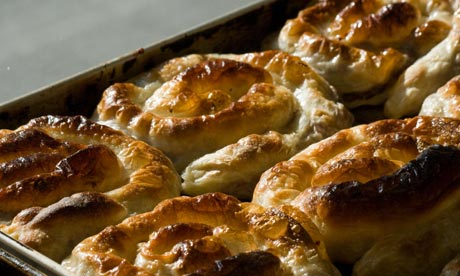 Photograph: Alamy
What is it?
Photograph: Alamy
What is it? Crisp yet moist, hearty yet subtly spiced,
burek is
the Balkan street food. Filo pastry is filled with aromatic minced meat, spinach (
zeljanica), or cheese and herbs (
sirnica),
then rolled, glossed with butter or olive oil and baked till golden.
Burek can be eaten at any hour: for breakfast accompanied by black tea,
or after a busy night in the bars of Sarajevo's Bašcaršija district.
Origin Burek originates in Turkey, where it is called
börek, from
Turkish
burmak (to twist).
Tasting
Though burek can be eaten hot or cold, it's best straight from the
oven. The pastry will be nicely flaky on the outside, but on the inside
it should be tender, with the consistency of perfectly cooked pasta. In
Bosnia it is cooked in great spirals, in round baking trays. Choose your
variety and the baker will slice it with a pizza cutter and wrap it in
butcher's paper for you.
Finding it In Sarajevo, bakeries (
pèkare) sell
burek by weight. Expect to pay around 3MK-5MK (£1.30-£2.15) for a good serving.
And in the UK … Kada from Moorish Feasts (
moorishcatering.co.uk) in Leeds makes a version of burek, wrapping two layers of filo round goat's cheese and lamb merguez. He serves it with
chakchouka, a red pepper sauce pepped up with cinnamon.
Sfenj, Morocco
What is it? As croissants are to the French, so are
sfenj
to Moroccans. They are uniquely spongy, deep-fried pastry rings made of
unsweetened, sticky yeast dough, with no milk or butter added. They are
noshed as a morning treat, then again in late afternoon.
Origin Believed to have been imported by Arabs in the 18th century,
sfenj were originally available from stands selling roasted lamb's head (a traditional breakfast dish) in the souks.
Tasting Amid the eye-popping and energy-sapping commotion of Morocco's labyrinthine medinas, sfenj
are a perfect boost. They should always be ordered fresh – you'll be able to witness their preparation. Sfenj
can
be hard to get right. The eating, though, is gratifyingly easy: when
sweetly garnished, sfenj are light confections of which just one is
rarely enough.
Finding it The best sfenj are prepared in
hanout (closet-sized
booths) in the medinas of Morocco's biggest cities, where they sell for
1 dirham (7p) each or 23 dirham (£1.75) a kilo.
And in the UK …
Kada of Moorish Feasts (as above) was voted Best Caterer at Glastonbury
for his sfenj. "I remember hot summer days on the beach in Algeria and
some little kid walking along the hot sand selling sfenj and mint tea
for a few dinars." Kada adds lemon or orange zest to the sugar, and
nigella seeds for authenticity.
Walkie-talkies, South Africa
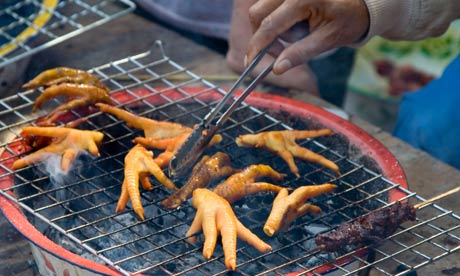 Photograph: Alamy
What is it?
Photograph: Alamy
What is it? Walkie-talkies are the feet (walkies)
and heads (talkies) of chickens. They are boiled together to facilitate
the removal of chewier bits, then the pieces are seasoned and cooked
according to taste.
Origin During apartheid,
wealthy farmers favoured the meatiest parts of the chicken. Leftovers –
such as heads and feet – were given to workers and people in the
townships.
Tasting Township markets are always a
wonder of sights, sounds and smells. Some walkie-talkies are boiled,
with added salt and spices; others are stewed with onions, green peppers
and tomatoes; lately, they are grilled, too. You stick the feet in your
mouth toes first, and scrape the skin and meat off with your teeth. The
rest can be chewed up for the bone marrow. It takes a bit of determined
crunching, but not as much as for the head, which is eaten whole (minus
beak).
Finding it Although best known at stalls
by inner-city taxi ranks and in the townships of Durban and Soweto,
walkie-talkies are sold countrywide for about 10 rand (85p) a kilo.
And in the UK … Hazvineyi Mapungwana of Shekinah African Food (
shekinahafricanfood.co.uk) in Keighley, West Yorkshire, serves walkie-talkies with
sadza (cornmeal) because she's from Zimbabwe. "In South Africa they eat them with
pap [maize porridge]. The heads and feet can either be dry-fried, with salt and pepper, or served in a stew."
Tamales, Mexico
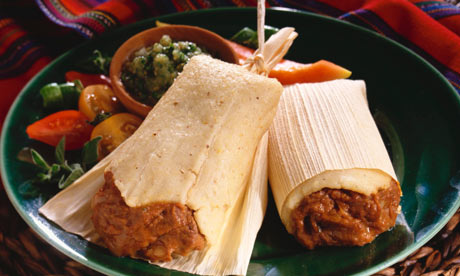 Photograph: The food passionates/Corbis
What is it?
Photograph: The food passionates/Corbis
What is it? Breakfast bliss or twilight snack, these
steamed, corn-husk-clad delights are pure comfort food, in sweet
savoury, spicy or bland versions.Pork or chicken with salsa or
mole are the most popular, along with
poblano chillies and cheese. The package is wrapped in corn husks or banana leaf and steamed until soft and seductive.
Origin Found all over Central and South America, tamales were a staple for Aztecs, Mayans and Incas.
Tasting Look
for vast steel containers leaking steam on pretty much every street
corner. This is a snack for even the most cautious gastronaut, as all
the steaming makes for a safe mouthful. The fillings are bit parts
compared with the steamed dough itself, which should sing of maize, with
a texture that subtly succumbs to the bite.
Finding it
Tamales Especiales in Coyoacán, Mexico City (Centenario 180, Col. del
Carmen) is a member of the Mexican Slow Food movement. It offers
takeaways during the week, with tables in the garden on Saturday and
Sunday nights. Tamales will set you back 10-15 pesos each (50p-75p).
And in the UK … Roland from London's Flaming Cactus (
flamingcactus.co.uk)
is trialling chicken tamales at festivals this summer. He's relaxed
about ingredients ("tamales are borne of poverty"), but will serve them
with sauce made from tomatillos – green tomatoes with a sharp citrus
flavour.
Red red, Ghana
What is it? Hot, sweet and spicy, red red pairs beans with fried plantains and
zomi
(red palm oil). The key to red red is one of the reds: zomi has a rich,
nutty taste. Onions and (red) chilli are fried in zomi and added to
black-eyed peas, then topped with more zomi and
gari (fermented dried cassava powder). Plantains (
koko, also red), sliced, salted and deep-fried, accompany the beans.
Origin
Everyone loves red red, but it's a favourite of the Ewe group from
eastern Ghana and Togo. Beans are an inexpensive protein, which makes
red red Ghana's national cheap lunch.
Tasting Red
red's natural habitat is lunch shacks and roadside stands. If you wait
near other diners, you'll hear "You are invited!" – the traditional
offering to share food. The red red is hot and the oil on the plantains
still sizzling when it is served, maybe on a dried plantain leaf. The
beans are soft and salty and the plantains soft and sweet with crispy
edges.
Finding it Red red is good everywhere, but
in the Community 12 region of Tema in Greater Accra, it's
extraordinary. A light-lunch portion costs one cedi (40p).
And in the UK … Adwoa Hagan-Mensah of
jollofpot.co.uk
in London has seen red red in Ghana cooked with snail, goat, even
bushrat. But in London, she says, they have "simplified the dish by
making it vegan, with no palm oil".
Currywurst, Germany
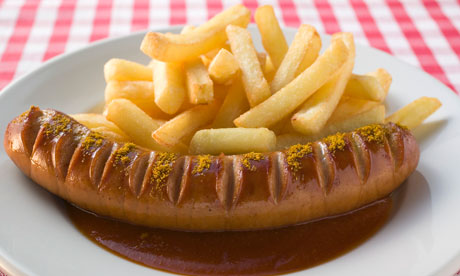 Photograph: The food passionates/Corbis
What is it?
Photograph: The food passionates/Corbis
What is it? Currywurst transforms sausage, chopped
and doused in a spicy tomato sauce, into night-time nirvana. Some favour
a sauce with Indian spicing; others prefer pure chilli heat. Then
there's the choice of chips, white bread or wholegrain roll …
Origin
In 1949 when Berlin lay in ruins, a woman called Herta Heuwer got hold
of some English curry power, added it to a tomato sauce and slathered it
over chopped sausage. Her stall, near what became the red-light
district, was popular with builders and labourers.
Tasting It's
been a long night. As you stumble home, you make out a beacon of red
neon light. The queues are long and rowdy, but with no hint of
aggression. You shuffle forward, mumble your order and proceed to lean
against a bright red Coca-Cola table. In the cardboard carton are two
sausages, chopped up and smothered in mildly spicy tomato sauce. You
stagger home happy, then return to see what it tastes like when sober.
It's every bit as good.
Finding it Currywurst 36,
at Mehringdamm 36 in Berlin, may be a tourist mecca, but the Currywurst
is damned good. Expect to pay €2 to €3.50 throughout Berlin.
And in the UK … Currywurst is often considered German junk food. But Babushkas (
babushkasonline.com)
in Cheadle, south Manchester, serves a healthy version. High
meat-content grilled bratwurst is served on roasted potatoes with a
home-made curry sauce rich in tomato, topped with fresh parsley and, for
those who like it hot, chilli flakes or cayenne pepper.
Street Food Festival: win tickets
Fancy trying some of these dishes? Lonely Planet has three pairs of tickets to its Street Food Festival (
crowdsurge.com/streetfoodfestival)
in London to give away to Guardian readers. Some of the capital's top
street food vendors will be at the two-night event, cooking a range of
recipes from The World's Best Street Food. The market will be in
Shoreditch on 28-29 March.
Tickets are available from 25 Febuary
2012 and cost £10 (plus booking fee) and include three dishes to try.
For your chance to win tickets to the preview of the event at 6pm on 28
March, email
streetfood@lonelyplanet.co.uk with "Guardian" in the email subject. The first three people to email will get a pair of tickets.

